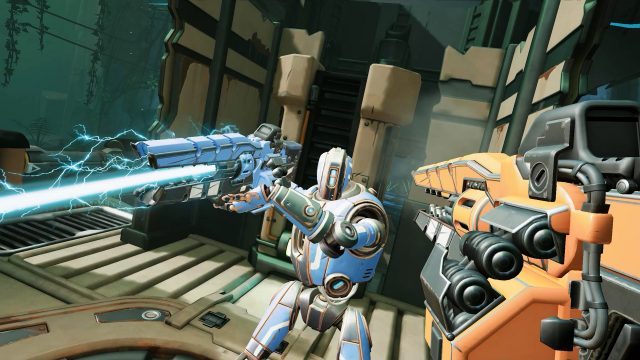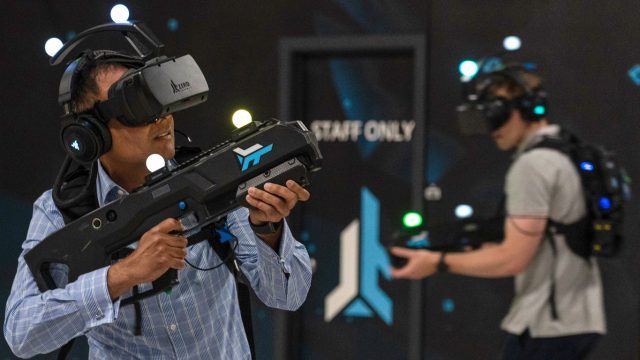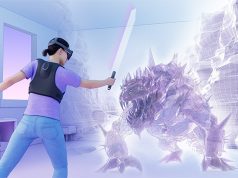The Rift and Distorting Virtual Space

In any standard FPS, VR or otherwise, when you die you simply respawn wherever the game wants you. In a free-roam VR environment where all locomotion is physical and the entire arena is shared space, the game clearly can’t just make you appear back at the spawn point—and that’s where ‘the rift’ comes in.
‘The rift’ is a sub-reality of sorts which handles one of the most challenging elements of free-roam VR PVP gameplay: space management. When players die, they are teleported to the rift which looks sort of like being inside of a sci-fi wormhole, but with a concrete floor that’s crawling with ghost-like avatars. The avatars represent every other real player in the arena, allowing dead players to run back to a pre-defined spawn point without bumping into others. Once the dead player makes their way back to their spawn point, they are spawned back to life on the map proper.
It might sound a bit complicated on paper, but it works surprisingly well and doesn’t require players to really understand what the rift’s function is behind the scenes. Dead players run back to their respawn points and pass right by living players, leaving them none the wiser. When you die and enter the rift, it’s fascinating to suddenly see where everyone else is located. Often times you’ll realize that enemy players were literally right next to you, only they were obscured at the time by a virtual wall—or even more bizarrely, virtual space distortion, but more on that in a moment.
The rift underlays all of the maps in Sol Raiders and is essential to the core gameplay, but it isn’t the only space management trick that Zero Latency has employed.
As PVP action is more fast-paced and a bit more frantic than the co-op games, it’s important that players not come too close to each other for fear of bumping into one another or accidentally smacking someone with the hefty gun. To create some buffer space around players, the avatars are oversized from the start, including virtual guns which are quite a bit longer and larger than their real-life counterparts. This is mostly invisible to the player, and ultimately tricks them into being extra conscious about their personal space because in VR it will look like they have less room than they actually do.

Zero Latency further uses virtual space distortion to turn Sol Raiders into something that’s dynamic in ways that real life small arena attractions like paintball or laser tag can’t be because of their physical limitations. The best example of this is on the third map where players from each side ride small gondolas away from their base towards a central platform where lots of close quarters fighting happens. In virtual reality, players feel like they’ve moved across a large space, but in reality they’re still standing right next to where they started.
This approach allows Zero Latency to create a virtual playspace that’s larger and even in different orientations than the real playspace, expanding the map beyond its physical boundaries. The map takes advantage of this fact by placing two elevators at each team’s main base which raise players up to a sniper perch which can shoot down toward the central platform. While players in the perch feel like they’re 20 feet in the air and shooting at enemies 50 feet away, in reality they’re standing on the same floor as everyone else, seemingly shooting at distant virtual enemies that are physically just feet away.
These systems work effectively and invisibily to make the three Sol Raiders maps feel unique and immersive. And while Zero Latency says this is just the start of their PVP ambitions, the potential is already plain to see.










